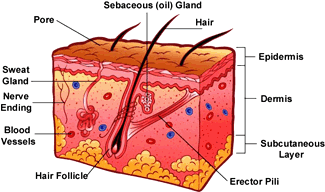9.- SKIN AND HAIR
Quick! What’s the body’s biggest organ?
You might be surprised to find out it’s the skin, which you might not think of as an organ. No matter how you think of it, your skin is very important. It covers and protects everything inside your body. Without skin, people’s muscles, bones, and organs would be hanging out all over the place. Skin holds everything together. It also:
- protects our bodies
- helps keep our bodies at just the right temperature
- allows us to have the sense of touch
Don’t Miss Your Epidermis
The skin is made up of three layers, each with its own important parts. The layer on the outside is called the epidermis (say: eh-pih-dur-mis). The epidermis is the part of your skin you can see.

Look down at your hands for a minute. Even though you can’t see anything happening, your epidermis is hard at work. At the bottom of the epidermis, new skin cells are forming.
When the cells are ready, they start moving toward the top of your epidermis. This trip takes about 2 weeks to a month. As newer cells continue to move up, older cells near the top die and rise to the surface of your skin. What you see on your hands (and everywhere else on your body) are really dead skin cells.
Dermis = Lots of Blood Vessels
Your dermis is also full of tiny blood vessels. These keep your skin cells healthy by bringing them the oxygen and nutrients they need and by taking away waste. These blood vessels are hard to see in kids, but you might get a better look if you check out your grandparents’ skin. As the dermis gets older, it gets thinner and easier to see through.
The Third Layer Is Subcutaneous Fat
The third and bottom layer of the skin is called the subcutaneous (say: sub-kyoo-tay-nee-us) layer. It is made mostly of fat and helps your body stay warm and absorb shocks, like if you bang into something or fall down. The subcutaneous layer also helps hold your skin to all the tissues underneath it.
This layer is where you’ll find the start of hair, too. Each hair on your body grows out of a tiny tube in the skin called a follicle (say: fah-lih-kul). Every follicle has its roots way down in the subcutaneous layer and continues up through the dermis.
You have hair follicles all over your body, except on your lips, the palms of your hands, and the soles of your feet. And you have more hair follicles in some places than in others — there are more than 100,000 follicles on your head alone!
Your hair follicles rely on your sebaceous glands to bring on the shine. Connected to each follicle in the dermis layer is a tiny sebaceous gland that releases sebum onto the hair. This lightly coats the hair with oil, giving it some shine and a little waterproofing.
When you think of your hair, you probably think of the hair on your head. But there’s hair on almost every part of your body. (Some places that don’t have hair include the lips, the palms of the hands, and the soles of the feet.)
Some of the hair on your body is easy to see, like your eyebrows and the hair on your head, arms, and legs. But other hair, like that on your cheek, is almost invisible.
Depending on where it is, hair has different jobs. The hair on your head keeps your head warm and provides a little cushioning for your skull. Eyelashes protect your eyes by decreasing the amount of light and dust that go into them, and eyebrows protect your eyes from sweat dripping down from your forehead.
Hair Comes From Where?
Whether hair is growing out of your head, arm, or ankle, it all rises out of the skin in the same way. It starts at the hair root, a place beneath the skin where cells band together to form keratin (the protein that hair is made of). The root is inside a follicle (say: fol-ih-kul), which is like a small tube in the skin.
As the hair begins to grow, it pushes up from the root and out of the follicle, through the skin where it can be seen. Tiny blood vessels at the base of every follicle feed the hair root to keep it growing. But once the hair is at the skin’s surface, the cells within the strand of hair aren’t alive anymore. The hair you see on every part of your body contains dead cells. That’s why it doesn’t cause pain when someone cuts your hair with scissors!
Nearly every hair follicle is attached to a sebaceous (say: sih-bay-shus) gland, which is sometimes called an oil gland. These sebaceous glands produce oil, which makes the hair shiny and a bit waterproof. Sometimes, like during puberty, these glands can pump out too much oil and a person’s hair may look greasy. Time for a shampoo!!
0 comentarios